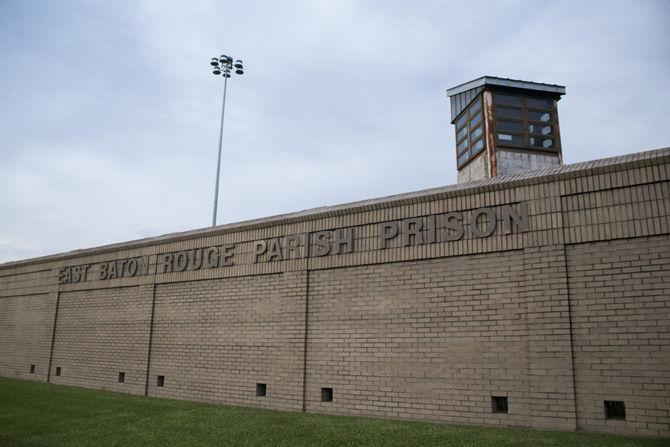LSU has been using prison inmate labor for decades, although many students may not have ever spotted the well-hidden landscape staff.
The inmates work in secluded areas and mainly on the weekends, said Executive Director of Facility & Property Oversight Tammy Millican.
“We’re very careful not to put them in the more populated areas of campus,” Millican said.
The University started the inmate labor support program in 1997 to supply labor resources for the campus at minimal cost, while also providing job skills for the inmates selected to participate.
“One of the missions of LSU is service to the community. So we look at that as a way we would be able to help them out,” Millican said.
She also attributed the program to major budget cuts made around the time.
There is an average of 28,000 hours per year of inmate labor provides to the University’s main campus. The University has a contract with the Dixon Correctional Institute, a Louisiana Department of Public Safety and Corrections facility in Jackson, to pay the correctional officers and provide meals for both correctional officers and inmates. Inmates themselves are unpaid. The state saved $1,068,000 for every 100 prisoners who completed the program.
Political Communication Assistant Professor Nathan Kalmoe thinks a few hours of fresh air and lunch at McDonald’s isn’t a fair trade for inmates who provide the labor.
“There are several problems that need to be addressed with the program,” Kalmoe said. “If they are doing work, they should be paid for that work.”
Another problem with the University’s contract with the Dixon Correctional Institute, Kalmoe said, is that Louisiana still ranks second in global incarceration rates. Louisiana was first, until it was surpassed by Oklahoma in 2018. Kalmoe said Louisiana’s criminal justice system disproportionately targets black residents as opposed to white residents.
Kalmoe made his views known by responding to a September tweet by artist and activist Bree Newsome Bass that said, “Slavery never ended. They turned the plantations into prisons. Never forget.”
“Predominantly white universities like LSU are among those using that coerced labor,” Kalmoe tweeted. “I’ve seen prisoners working on campus all week in 95+ degree heat. For a school struggling to embody the diversity of Louisiana, one step should be to abolish slavery on campus.”
He tagged University President F. King Alexander in the tweet, and later tweeted that Alexander had unfollowed him.
Inmates on the University’s campus perform landscape services, such as cleaning up grounds after game days, while being supervised by correctional officers and working alongside LSU Facility Services staff.
Inmates who participate in the program are chosen by the corrections department and are always non-violent offenders, Millican said.
“We’ve been doing this since 1997. We’ve never had a discipline issue,” Millican said. “It is a privilege for them to come here, and they see it as such.”
Millican also noted that although the correctional facility chooses the inmates for the program, no one is forced participate.
African Americans constitute an overwhelming majority in Louisiana’s prison system (66%), although they make up only 32% of the state’s population. Additionally, 90% of those serving life without parole sentences for non-violent crimes are black, according to the American Civil Liberties Union.
“You see this especially in low-level crimes,” Kalmoe said. “Studies in Baton Rouge find even though white and black rates of drug use are similar, neighborhoods with a large portion of black residents have higher incarceration rates, greater arrest rates and harsher punishments.”
Drug use varies little across zip-codes in Baton Rouge, according to a study conducted by Together Baton Rouge. However, rates of police enforcement for drug possession vary dramatically among neighborhoods.
High-enforcement areas are 90% black and have five times as many arrests for drug possession than low-enforcement areas. The median household income for high-enforcement area residents is $26,762.
Low-enforcement areas are 63% white, and have a median household income of $53,636. An estimated 8.3% of low-enforcement area residents are drug users, as opposed to 7.6% of their high-enforcement counterparts, according to the study.
Kalmoe, who referred to inmate-labor practices as a “loophole for the 13th Amendment,” said he would prefer to see the state save money by lowering incarceration rates than by using inmates to do work on behalf of the state.
He also said it is a detriment to the University’s efforts to attract diverse freshman classes, something the University has recently prided itself on.
In September, the LSU Media Center reported the University had broken the record for its largest and most diverse freshman class for the second year in a row. The diversity of this year’s freshman class increased by more than 7%, according to the Media Center.
“LSU has a history of racial exclusion that the University’s trying to fix,” Kalmoe said. “It’s difficult to attract a student body that reflects racial diversity when you have prisoners on our campus that are disproportionately black working on campus for no pay.”
Louisiana is one of a handful of states that rely on prison labor to maintain government buildings. The program was expanded in March 2018, but some state lawmakers opposed it.
“We’re doing something that I think is morally out of place,” Rep. Ted James, D-Baton Rouge, said in a March 2018 Times-Picayune article. “Some inmates that work full time while incarcerated don’t have enough money to get an apartment when released from prison.”
State prisoners hold a variety of jobs in the Governor’s Mansion and the State Capitol, as well as other government facilities. Inmates can opt to be paid four to 70 cents an hour or work to earn credit toward their release.
Democratic Gov. John Bel Edwards supported the program’s expansion, which allowed prisoners to do work outside of custodial jobs.
Kalmoe said he did not know if Alexander had a say in whether prisoners worked on campus, but he hopes Alexander will use his influence to end the controversial practice.
“I know he has a better chance of influencing the governor and the legislature to make changes than I do,” Kalmoe said. “I hope he’ll use his leadership position to work for change, not just on campus but also statewide.”
Nick Frewin contributed to this report.
LSU professor speaks out against University’s prison inmate labor practices
November 20, 2019
Mental illness education vital to prison reform at East Baton Rouge Parish Prison, on Monday, Aug. 21, 2017.







